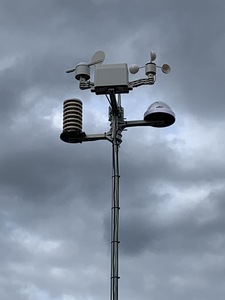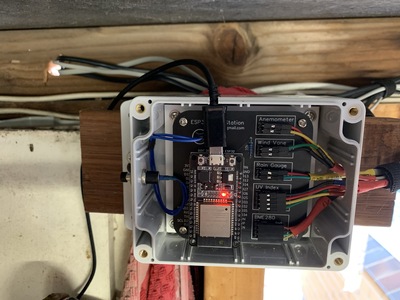I am building a full weather station, that is wind direction and speed, air temperature,humidity, ground temperature, rainfall detection and amount.
The above list will be read remotely using a nRF24L01 transceiver to transmit the data to the base station, which will also record indoor temperature and pressure.
I have used a dht22 and am2302 with success but the dht22s failed after a short time and also one of the am2302s, the other am2302 has a very inaccurate humidity sensor.
I would like to use an am2320 as it seems more accurate and I have tried to use it with the nRF24L01 but as it is an I2C sensor I cannot get it to work.
all using Arduino UNOs unless I run out of memory of course.
can anyone help with the am2320 sketch please as I am far from proficient at c++. Thanks.
Perhaps having different Stations for the various things to xmit to Base?
One for Soil, Temp, & humidity... maybe just using a Nano (or smaller)?
One for wind speed & direction...
Each on xmiting a Code to denote what it is... like a Station# followed by the data to report?
Your BIG program would at the Base which will save and process the data received... UNO or even a Mega for more memory... and SDcard for storage.
I've been toying with the same type project... It seems like, when I finally get an idea that I like, something else pops up...
Like using an ESP32 instead of Arduino! ESP32 CAM for even Video... Then WiFi sounds like the best way to go! There are more questions to be answered on that NOW! More Fun! Eh? ESP being much Faster and having more memory, operating at 3.3v possibly making batteries last longer, etc. ESP having a lot of sensors BUILT-IN too! More to think about...
Have Fun,
Joe Lyddon
www.woodworkstuff.net
Hi There,
Have a look at this, good tutorial from Aadafruit . . . https://learn.adafruit.com/adafruit-am2320-temperature-humidity-i2c-sensor/arduino-usage
I2C is pretty straightforward, usually plug-n-play, if you can post the code your are using we can have a look. What errors are you getting?
billd
PS: I have made similar using ESP32 with a bunch of sensors
I've had good luck so far with the BME 280 pressure, temperature and humidity sensor. It still uses I2C but I found that is a good thing as you can quickly run out of GPIO pins running the various sensors associated with weather. There are a number of library and code examples available for this sensor.
I ended up using an ESP32 (after starting with a UNO and an ESP8266) to monitor the sensors and send data through WiFi for both recording of data to Google Sheets and a web host for real-time data. The real-time data is only available on my local network but using Google Sheets allows global access to my data with no fees and no worries about security.
Hi Billdo1. Thank you for responding to my request in August. Some other items needed attention so I had to leave my work on the weather station to one side until I had finished the other work. The weather station is considered a hobby project so it only gets attention when there is nothing else on the agenda. I have a system from Sparkfun which has inputs for wind direction and speed, rainfall, temperature, humidity, pressure, and a gps unit. It works well but it is not a wireless system, the wind and rain sensors are outside and wired in, the rest are indoors on the shield.
What I would like is the outdoor sensors (wind, rain, temperature, humidity, ground temperature) read remotely and wirelessly sent indoors with temperature, humidity and pressure readings read indoors as well. All displayed on a screen such as an OLED, or monitor.
I see you use an ESP32 to collect the data. I know nothing of the ESP32 but I had a look at it and it is away out of my depth of knowledge. I know very little of C++ so I have no hope of working with ESP32 at the moment.
Hi Joe. Thank you for replying to my request for help in August last. I am afraid other things get priority over my hobby which at the present time is the weather station. Hardware configuration is no problem but software is and this is my stumbling block. I have seen some systems using multiple transmitting stations with NRF24L01 as master and NRF24L01 also as slaves. My big problem is coding for the sensors so that the data is transmitted, received and displayed correctly.
I know nothing about the ESP32, I had a look at the information on it and to be honest it is way over my head at the moment. To use it in the remote transmitter mode I think it is a waste of a unit as it has so many features on it that would not be used in my system. It would need a larger power supply as the WIFI would need more current to operate reliably. The software to operate communications between two ESP32s and a display system such as a computer screen or a smartphone is complicated (for me anyway).
I must look at your suggestion of using a number of NRF24L01s and say NANOs at the Transmitting stations and either a UNO or a MEGA as the receiving station. It will probably take me the winter months to try and code the different stations. I will have a go anyway.
Hi.. Sorry to be so late in responding. been very bust with other things.
I have not gotten into the details of using the NRF24L's yet... I'm torn in trying to decide which is best WiFi, if could do the job seems to be the best BUT, I don't know yet...
I think the NRF24L approach might be best... but, I have not had the time to really dig into it yet...
There are so many ways & things to decide upon...
Hope you are making progress...
Have Fun,
Joe Lyddon
www.woodworkstuff.net


